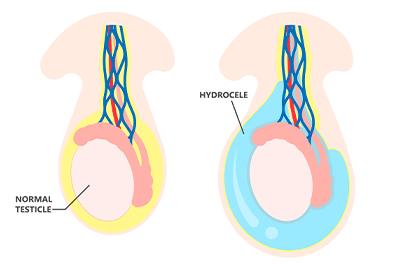A pediatric hydrocele (hy·dro·cele) is a fluid-filled sac located around a testicle that causes swelling in a male’s scrotum (pouch of skin that holds the testicles).
Overview
What is a pediatric hydrocele?

A hydrocele is a fluid-filled sac that develops around a testicle, which causes swelling in the scrotum.
In a healthy baby, the testicles descend (drop) from the baby's developing abdomen into the scrotum. A sac accompanies each of the testicles, which allows fluid to surround the testicles. Once the testicles are in place, each sac closes and the fluid is absorbed. A hydrocele forms when some of this fluid remains.
Risk factors
These are common in newborns and typically disappear on their own within the first year of life. It's possible for older boys and adult men to develop a hydrocele, usually due to inflammation or injury within the scrotum.
Diagnosis
How is a pediatric hydrocele diagnosed?
Hydroceles are generally smooth and do not cause pain in infants. Large or painful hydroceles may need more immediate attention. Because a hydrocele can resemble an inguinal hernia, doctors make a diagnosis based on a physical examination and a complete medical history. Transillumination can differentiate between a hydrocele and a hernia.
Treatment
How is a pediatric hydrocele treated?
Surgery (hydrocelectomy) can be performed through a small incision in the groin or by using the laparoscope (minimally invasive surgery). Depending on the age of your child, some surgeons may recommend looking for a hernia on the other side at the same time as the initial hernia surgery.
Doctors and Providers
 Craig Andrew PetersPediatric Urologist
Craig Andrew PetersPediatric Urologist Adam Craig AlderPediatric Surgeon
Adam Craig AlderPediatric Surgeon Alexandra Maria Ciota CarolanPediatric Urologist
Alexandra Maria Ciota CarolanPediatric Urologist Natasha Marie CorbittPediatric Surgeon
Natasha Marie CorbittPediatric Surgeon Diana Leigh DiesenPediatric Surgeon
Diana Leigh DiesenPediatric Surgeon David Harris EwaltPediatric Urologist
David Harris EwaltPediatric Urologist Barbara Anne GainesPediatric Surgeon
Barbara Anne GainesPediatric Surgeon Lauren Ann GilloryPediatric Surgeon
Lauren Ann GilloryPediatric Surgeon Russell HawkinsPediatric Surgeon
Russell HawkinsPediatric Surgeon Charles Robert HongPediatric Surgeon
Charles Robert HongPediatric Surgeon Micah A JacobsPediatric Urologist
Micah A JacobsPediatric Urologist Stephen Mark MegisonPediatric Surgeon
Stephen Mark MegisonPediatric Surgeon Carrie Colleen Buchanan MoorePediatric Surgeon
Carrie Colleen Buchanan MoorePediatric Surgeon Joseph Thomas MurphyPediatric Surgeon
Joseph Thomas MurphyPediatric Surgeon Samir R PandyaPediatric Surgeon
Samir R PandyaPediatric Surgeon Laura Nanka PurcellPediatric Surgeon
Laura Nanka PurcellPediatric Surgeon Bruce Jeremy SchlomerPediatric Urologist
Bruce Jeremy SchlomerPediatric Urologist Irina StanaselPediatric Urologist
Irina StanaselPediatric Urologist Karen Caddell PritzkerNurse Practitioner - Urology
Karen Caddell PritzkerNurse Practitioner - Urology Janelle Marie TraylorNurse Practitioner - Urology
Janelle Marie TraylorNurse Practitioner - Urology